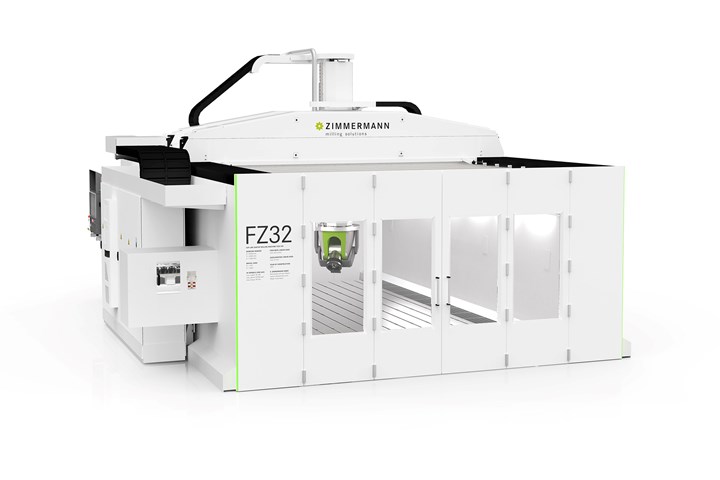Five-Axis Portal Milling Machine Line Features Thermosymmetical Design
Zimmerman’s newly developed FZP series for model, tool and die makers are compact, flexible and highly accurate.

Photo Credit: Zimmerman Inc.
Zimmerman Inc.’s FZP five-axis portal milling machine line responds to the requirements model, tool and die makers face to deliver near-perfect surfaces and consistently high dimensional accuracy at competitive prices under increasingly tight deadlines. The FZP is customizable, saves space and is thermostable, all owed to its thermosymmetical—a concept first introduced in Zimmerman’s 2017 FZU portal milling machine line—design with a center-guided Z-slide. It also aids in reducing throughput time for workpieces and offers a comprehensive range of additional options.
Developers placed particular emphasis on the customizability of the machines. FZP’s structure can be varied in length and width with different vertical slides and gantries, to adapt to a wide range of workpiece sizes. The “lightest” machine in the FZP line is the FZP32 with a working range of up to X=10, Y=4 and Z=2.5 meters (393" x 157" x 98"). Machine blocking plastics as well as carbon and glass fiber-reinforced polymers (CFRP and GFRP) and aluminum, among other materials, is possible. Due to its large working area, milling components completely without reclamping is also feasible.
Thermosymmetry, which is based on the fact that inevitable thermal influences can be absorbed to a considerable extent by the design of the machine structure, was also considered in the FZP line’s design. As a result, the line’s milling spindle, guides and other accuracy-determining components have been arranged so their heating is either absorbed or can expand in non-critical directions. The gantry's center-guided Z-slide in double-bridge design, for example, has an octagonal cross-section that makes it particularly stable. Comparable systems usually use complex cooling or software-based compensation for this purpose, Zimmerman notes.
The Zimmermann VH10 milling head is also a feature used on this machine line. The fork head is designed in monoblock versions made of cast iron. It is compactly built, has minimal interference contours and achieves high clamping forces, thus enabling stable component machining. Zimmermann optionally equips the VH10 milling head with process cooling via cooling lubricants and minimum quantity lubrication. To reduce throughput times, a spindle with 34 kilowatts (45 horsepower) at a maximum speed of 24,000 rpm is used as standard in the milling head. Moreover, the VH10 has been equipped with a dust extraction bell around the milling tool, making it suitable for abrasive and harmful materials such as GRP or CFRP, which are used in aircraft construction. The dust extraction system captures the dust directly at the point of origin, reducing contamination of the interior.
Zimmermann also offers its FZP machines with larger tool magazines, pallet changers or carousel rotary tables on request. This reportedly allows users to reduce downtime and increase automation.
Zimmerman expects to launch the medium-segment FZP37 based on a new double-bridge gantry and the heavy-segment FZP42 for the mold and die industry. FZP42 will be in the 1,000 newton-meter (737 ft-lb) torque range.
Related Content
-
How to Analyze and Optimize Cutting Conditions to Reduce Cycle Time
Plastic injection mold design and manufacturing company puts NC program optimization software module to the test. The results were surprising.
-
Tips for Tackling Mold Design, Machining, Cutting Tool and Wear Challenges
Tips for tasks ranging from reducing risk in part design and taking advantage of five-axis machining to refining cutting tool performance and reducing wear with guiding and centering systems.
-
How Industrial Molds Conquered a Complex Impeller Fan Mold Challenge
Expert engineering team overcomes complex impeller fan mold challenges through innovation, precision and collaborative problem-solving.














